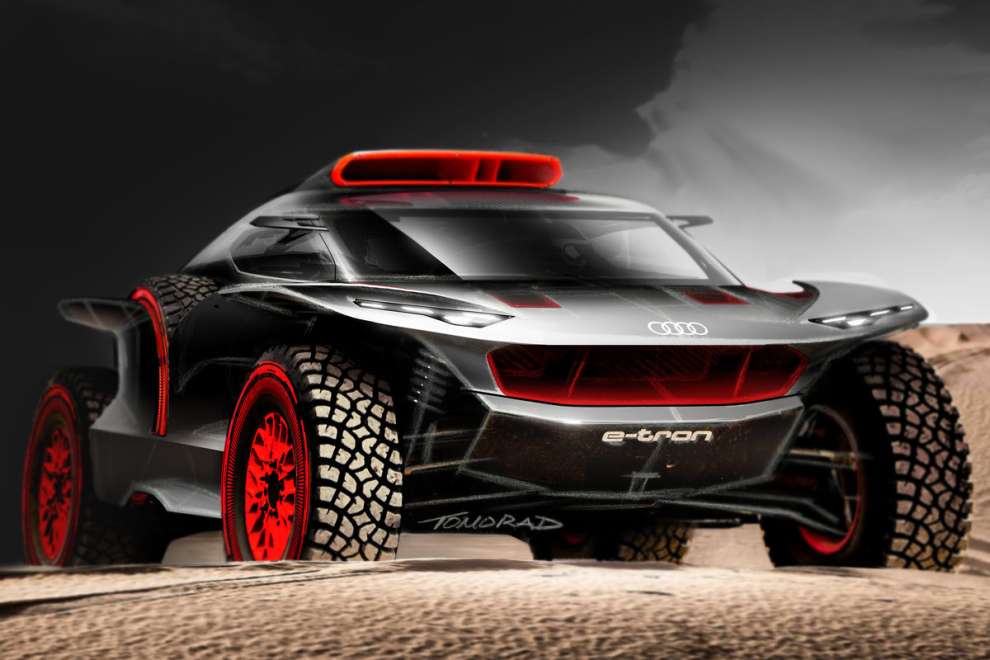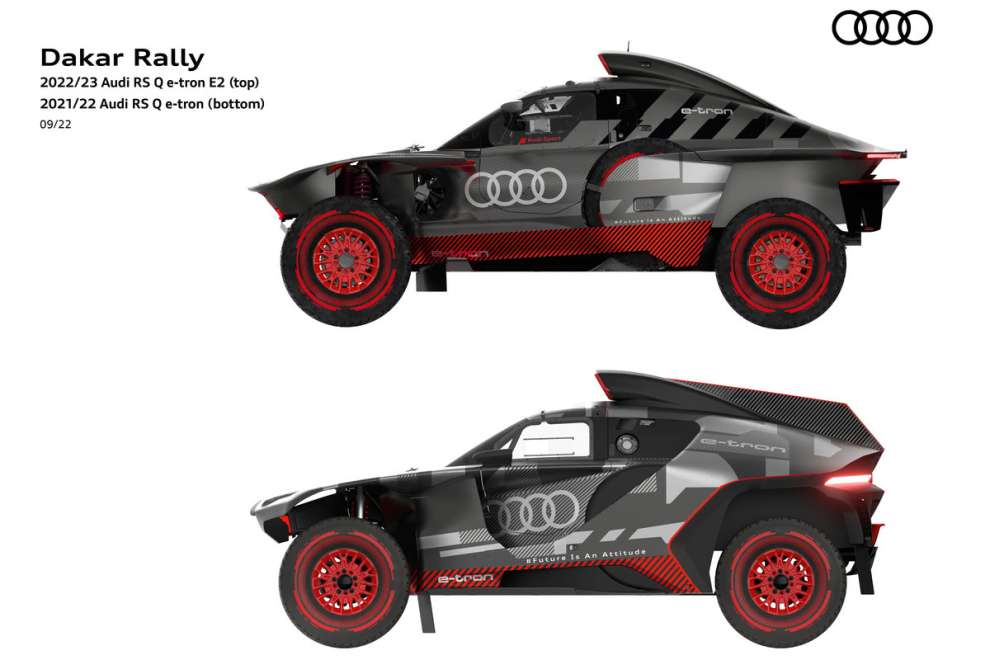With the success of Carlos Sainz and Lucas Cruz, Audi becomes the first manufacturer in the world to win the Dakar with an electrified car. An event of historic significance, because if it is true that hybrid technology has been widespread in the world of competitions for years, rally raids were still unexplored territory due to the climatic and durability challenges they pose. A real mountain to climb, to which the house of the four rings dedicated a four-year project.
The idea
The program takes its first steps in 2020, guided by a clear ambition: to demonstrate to the world that an electrified prototype is capable of tackling and winning the Dakar. The historic raid represents the ultimate test for electric technology, particularly sensitive to high temperatures and vibrations, conditions that are the order of the day in the famous rally. Among the difficulties of the electric one is above all being able to guarantee a constant level of power, preventing overheating, loss of efficiency and performance of the engines, in a competition in which the stages can even last 5 hours. Furthermore, unlike circuit races, it is not possible to predict with exact precision the path to follow, forcing the use of the most flexible energy management logics.
Audi, however, does not let itself be discouraged. The RS Q e-tron takes shape around an 800 Volt, 52 kWh lithium-ion battery pack, located under the passenger compartment. The powertrain has three electric motors, the developed MGU05s during the years of the Formula E program. More than motors, we are talking about driving modules, the single blocks comprising the six-phase permanent magnet electric motor, the inverter and the cooling circuit, for a peak efficiency of 97% and a maximum speed of 2000 rpm . Two modules are mounted on the front and rear axles, thus ensuring all-wheel drive. Furthermore, the engines, with a power of 250 kW each, are oversized if we consider that the overall power is limited by regulation to 260 kW (357 horsepower). Precisely this choice, however, allows, if necessary, to transfer greater torque and power to one of the two axles based on the available grip, simulating a central differential in virtual form.
The third generator does not deliver power to the wheels, but rather acts as an energy converter. In fact, as powerful as it is, the 52 kWh battery is not capable of completing a stage lasting hundreds of kilometers on its own. This instead needs to be constantly recharged, a task that falls to the third electric generator, set in motion by a combustion engine. The thermal is the 2-litre turbo 4-cylinder with direct injection which comes from the DTM Audi. The original unit is modified in the pistons, injectors and other components, going from 580 to around 300 horsepower, but with the advantage of generating 1 kWh of energy with just 200 grams of fuel. In fact, having to recharge the battery at a constant power, the engine works in a narrow rotation range, between 4500 and 6000 rpm, where efficiency is maximum. The low consumption allows Audi to fit a tank of just 340 litres, a significant saving compared to the 540 of its rivals, ensuring a small but important advantage.
The challenges of the project
The choice to focus on an electrified powertrain brings with it various complications, but also greater mechanical simplicity. Thanks to all-electric traction, Audi can do without a multi-gear gearbox and central differential, replaced by electronic control of the two engines. The braking contribution of the two generators also reduces stress on the calipers and disc brakes, an opportunity to fit lighter components.
Nonetheless, weight is one of the major limitations of the project, given the 370 kg of the traction battery alone. The problem is double, which affects both performance and reliability. The RS Q e-tron, in fact, exceeds the regulatory minimum of 2100 kg, an overweight that puts the suspension to the test and does not speak in favor of reliability. Yet, in the debut edition of 2022 all three Audis reached the finish line, taking 4 stage victories, without however going beyond the ninth place finish with Ekstrom-Bergkvist.

Development
The first updates on the RS Q e-tron arrive for the following year, starting from a new bodywork, more aerodynamically efficient. Audi manages to reduce around 15% of the aerodynamic resistance, despite the wider cockpit compared to the initial version. On a software level, it comes improved delivery control of electric power, limiting the energy wasted during wheel slip phases, an improvement that allows you to save energy, while also protecting yourself from penalties from race direction. Last, but not least, comes improved thermal management of the entire car, from the powertrain to the passenger compartment. Cooling fans, pumps and air conditioning now follow an intermittent control logic, which allows for a reduction in energy expenditure, to be reinvested in the thrust of the car.
A little help also comes from the Balance of Performance, which grants Audi a maximum power of 263 kW, then increased to 271 kW halfway through the rally. Despite the numerous improvements, the 2023 Dakar proves to be even more disappointing than the previous edition. Only one Audi sees the finish line, arriving in fourteenth position, but what is more alarming are the withdrawals of the other two RS Q e-trons, motivated by the physical repercussions suffered by the crews. Carlos Sainz in particular makes up for it two broken ribs, something Audi is determined to remedy.

The last assault
Audi's sporting resources are now all diverted to the start of the Formula 1 program, with 2024 remaining the last year for the success of the Dakar project before its closure. We decide to intervene on reliability by installing some reinforced rims and tires with greater shoulder stiffness, with the side effect however of intensifying the shocks transmitted to the passenger compartment. Thus we also work on springs, shock absorbers and suspension stops, with the aim of dampening forces and vibrations.
“Our goal was to reduce vertical acceleration peaks during landings after jumps”explains Leonardo Pascali, appointed new technical director on the eve of the 2024 campaign. The Italian's words reveal a certain attention paid to the safety of the crews after the accidents of the previous year, so much so that he even studied a new shock-absorbing foam for the seats. Remarkable is the work carried out on the front impact structure, now capable of absorbing up to four times the energy compared to the 2023 version.
Reliability is established as one of the development priorities, but performance is no different. A intense lightening work allows Audi to finally get closer to the minimum weight of 2100 kg, thanks also to renewed components such as the brake calipers and the front and rear bonnets. Nothing is left to chance, as demonstrated by the new wheel hub holders, designed to facilitate easier evacuation of stones and debris, preventing further breakages. Finally, a new distribution of torque between the front and rear axle is being studied, also in light of the greater power granted by the Balance of Performance, which rises to 286 kW.

After the failures of previous years, some opponents have little faith in Audi's chances of winning, prompting Nasser Al-Attiyah to prophesy its withdrawal after three days. The music in 2024, however, is very different, so much so that it is the Qatari who has to retire, while Carlos Sainz celebrates his fourth victory in the Dakar after a long duel with Sebastien Loeb. The Spaniard tells FormulaPassion: “With these statements, Al-Attiyah achieved the opposite effect to what he hoped for in my opinion, because he pushed the whole of Audi to do an even better job than what they were already preparing to do. A company like Audi, officially involved in the Dakar, couldn't afford to go home after three days and Nasser's words did nothing but serve as a stimulus”. Audi can thus greet the Dakar as a winner, with the awareness of having written an important page in the history of motorsport.
#DTM #Formula #Audi #won #Dakar